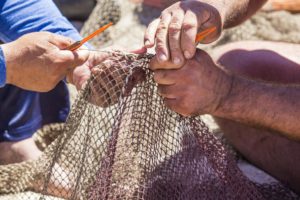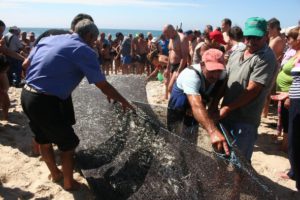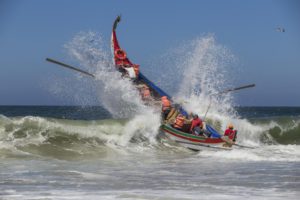Arte Xávega
The first fishing to exist in the village was that of Arte Xávega, with half-moon type sloop boats.
Xávega was sometimes very long and pulled ashore by several fishermen. It was a type of artisanal fishing, but it consisted of the only means of subsistence for the inhabitants of the village. Xávega’s own boat, characteristic of Murtosa, was about 4.60m long, about 2.35m wide and about 0.75m deep. The morphology of this boat is adjusted to the local maritime conditions, in which the operations of entering and leaving the sea are particularly critical.
The caulkers designed the Xávega boat in order to adapt it to the Murtosa’s characteristics, in particular with regard to the bow and stern: in addition to its flat bottom, it had a very raised and sharp bow to cut the waves and a stern or “cut” stern to take advantage of the wave on the ground and to allow the nets to be quickly thrown into the sea. The vessel goes out to sea, the net is cast in a circle, starting the trawling process, after returning to the beach, tying the hauling lines to a yoke of oxen, so that the fishermen start pulling the nets.
The boat has undergone several transformations throughout its history. Today, they continue to be built in shipyards next to the Ria de Aveiro, and the contemporary boat can take between 8 and 12 men. They fish daily and seasonally, between March and October. Nowadays, you can still observe this type of fishing on our beaches, and nowadays the nets are pulled by tractors instead of oxen.
Its origin dates back to the Pre-Classical and Classical civilizations of the Mediterranean Sea, which used small boats and hand hauling nets. Later, and during the Muslim occupation of the Iberian Peninsula, this type of net used in coastal maritime fishing appears with the designation of “Xábaka” and its expansion through Spanish Andalusia and the Portuguese Algarve gave rise to new expressions such as “Jábega”, “Xávega” or “Rinse”.




